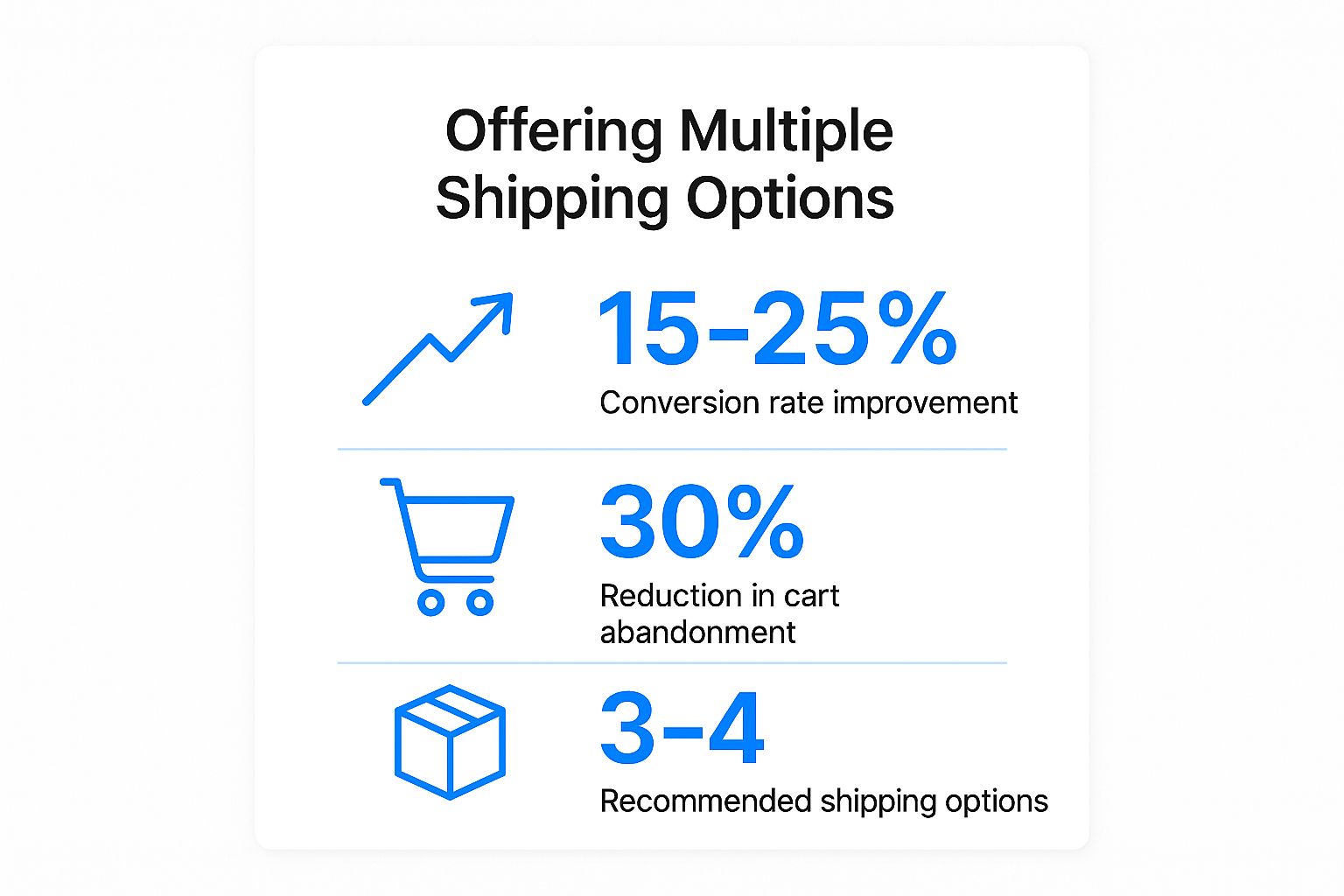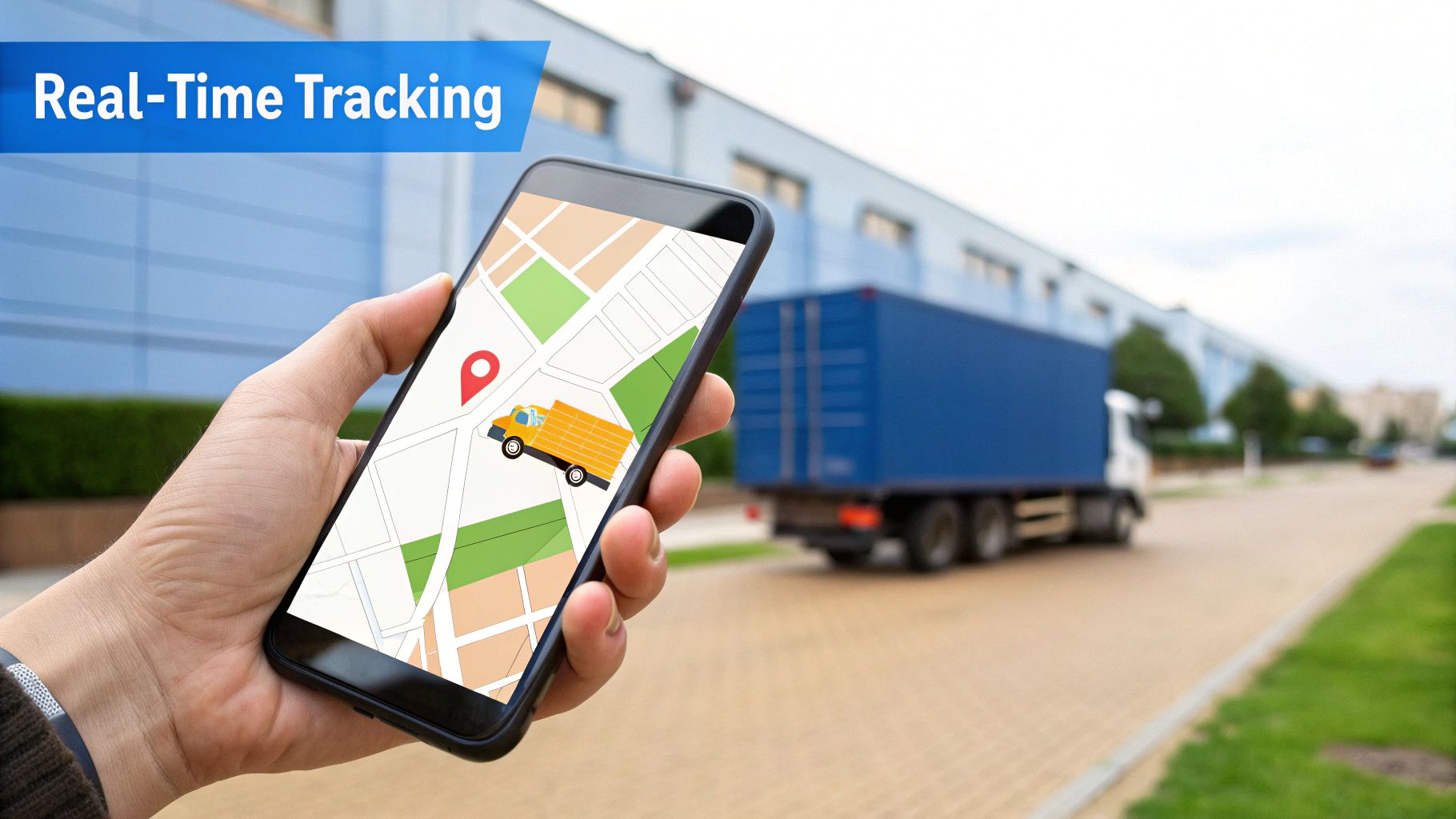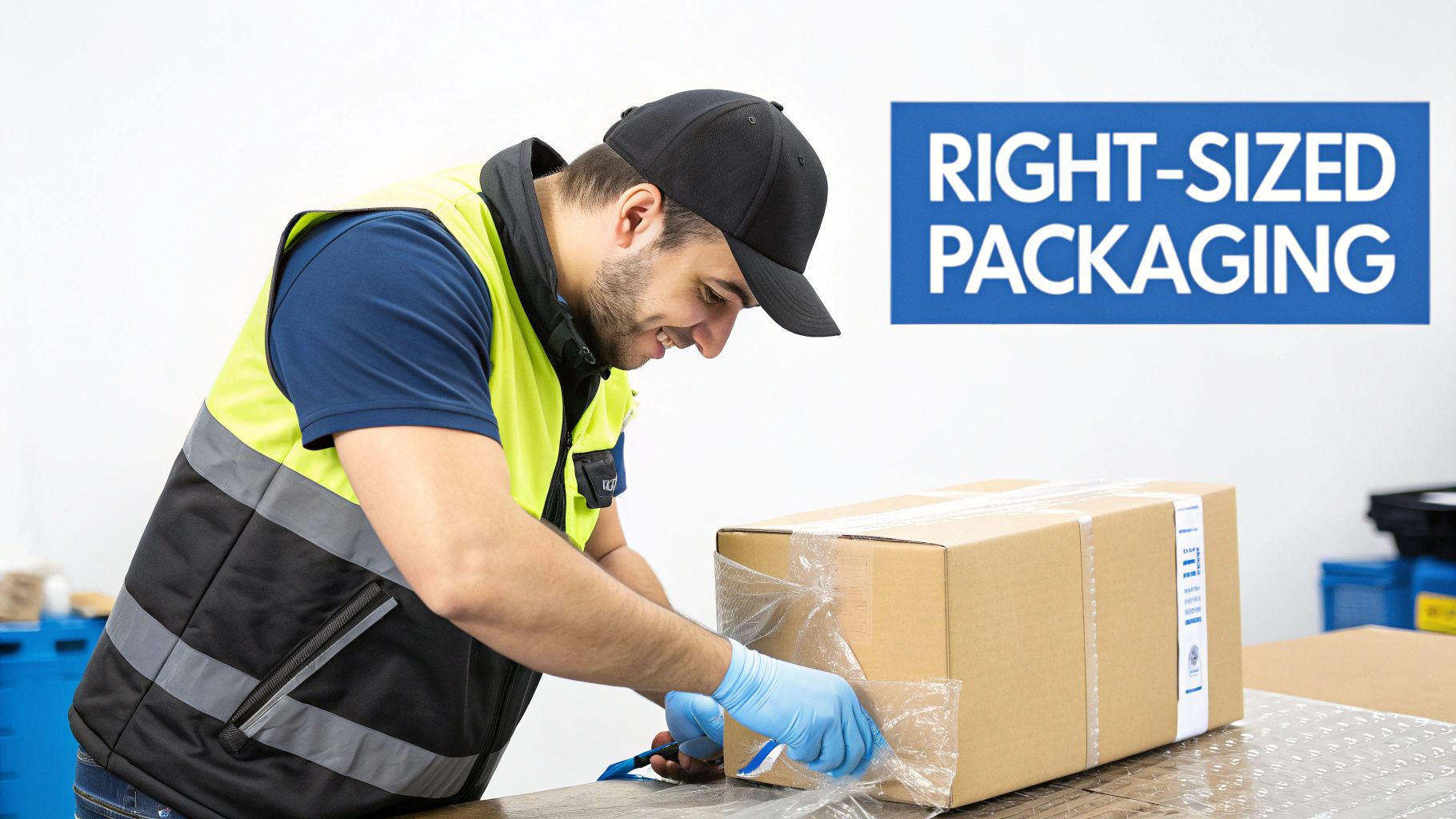In the world of ecommerce, the final mile is often the most critical. While a great product and a seamless website are essential, your shipping strategy is what bridges the gap between a customer's click on "buy now" and the tangible experience of receiving their order. It's a pivotal touchpoint that directly influences customer satisfaction, repeat business, and ultimately, your bottom line. A poorly executed shipping process can lead to abandoned carts, negative reviews, and high operational costs, eroding your hard-earned customer loyalty and profit margins.
Conversely, mastering your shipping operations can become a powerful competitive advantage. It's not just about moving a box from point A to point B; it’s about creating a reliable, transparent, and positive post-purchase experience that builds trust and encourages customers to return. Getting this right means lower costs, happier customers, and a more scalable business model.
This guide moves beyond generic advice to provide a comprehensive roundup of ecommerce shipping best practices. We will explore actionable strategies designed for growing brands, from emerging DTC companies to established retailers on platforms like Shopify and WooCommerce. You will learn how to:
By implementing these proven tactics, you can transform your shipping from a necessary expense into a strategic asset that fuels growth, delights customers, and solidifies your brand's reputation for excellence. Let's dive into the specific practices that will help you deliver a superior experience from checkout to doorstep.
One of the most impactful ecommerce shipping best practices is to empower customers with choice. A one-size-fits-all shipping strategy can alienate potential buyers who have different priorities regarding speed and cost. By providing a curated selection of shipping options, you cater to a wider audience, from the budget-conscious shopper willing to wait a few extra days to the last-minute buyer who needs their order overnight.
This approach involves presenting several distinct delivery tiers at checkout. Major retailers like Target and Best Buy master this by offering a mix of standard shipping, expedited delivery, and convenient local pickup options. The goal is to let the customer control the balance between price and convenience, a key factor in their final purchase decision. When customers feel they have control over their delivery experience, their satisfaction and loyalty increase significantly.
To implement this effectively, focus on clarity and value. Avoid overwhelming customers with too many choices, which can lead to decision paralysis.
This following infographic highlights key statistics on the impact of providing multiple shipping choices.

These metrics clearly demonstrate that giving customers shipping choices directly boosts conversions and cuts down on abandoned carts, proving its value as a core strategy. For those operating on competitive platforms, understanding how to configure these choices is crucial. You can explore a detailed guide to Amazon seller shipping options on Simpl Fulfillment's blog to see how this is applied in a major marketplace.
In today’s on-demand economy, post-purchase transparency is no longer a luxury, it’s an expectation. Providing customers with real-time order tracking is a critical ecommerce shipping best practice that directly addresses the common question, "Where is my order?" By offering a clear, accessible way for customers to monitor their shipment's journey from your warehouse to their doorstep, you build trust, reduce customer anxiety, and significantly lower the volume of support inquiries.
This practice transforms the post-purchase experience from a "black box" of uncertainty into an engaging and reassuring process. Leading brands like Nike and Zappos have perfected this by offering detailed tracking pages that include estimated delivery windows and even delivery confirmation photos. This level of transparency not only keeps the customer informed but also reinforces the reliability and professionalism of your brand, turning a simple transactional update into a positive touchpoint.

Effective tracking is about being proactive and making information easy to access. The key is to deliver timely updates through multiple channels, ensuring the customer never has to hunt for information.
This approach is essential for any ecommerce business looking to improve customer retention. By providing clear, real-time tracking, you manage expectations effectively and demonstrate a commitment to a superior customer experience. This element of your shipping strategy is a powerful tool for building long-term loyalty. For a deeper look at how tracking and other post-purchase experiences can be enhanced, you can find valuable insights on the AfterShip Blog, which specializes in this area.
Beyond the shipping label, the box itself is a critical lever for efficiency and customer satisfaction. A core ecommerce shipping best practice is to strategically optimize your packaging. This means selecting materials and dimensions that minimize shipping costs by reducing dimensional weight (DIM weight) while ensuring products arrive intact and damage-free. It’s a careful balance between protection, cost, and brand presentation.

Industry leaders exemplify this approach. Amazon’s Frustration-Free Packaging program focuses on right-sized, recyclable boxes that are easy to open, reducing waste and shipping volume. Similarly, Apple’s minimalist yet robust packaging protects premium electronics with precision-engineered inserts, creating a memorable unboxing experience without excess material. This strategic thinking transforms packaging from a mere container into a powerful tool for cost savings and brand reinforcement.
To implement optimized packaging, you must be systematic and data-driven. The goal is to eliminate wasted space and unnecessary materials without compromising product safety.
This video from a packaging expert offers a visual guide to right-sizing and its impact on shipping expenses.
By systematically analyzing and improving your packaging, you directly address one of the biggest variable expenses in your operation. These efforts not only cut down on carrier fees but also reduce material costs and enhance your brand's commitment to sustainability. To dive deeper into specific tactics, you can explore this guide to optimizing ecommerce shipping costs on Simpl Fulfillment's blog.
One of the most effective psychological tools in an ecommerce shipping best practices playbook is the free shipping threshold. Instead of absorbing the cost of free shipping on all orders, this strategy encourages customers to spend more by offering free delivery only after their cart reaches a certain minimum value. This nudges customers to add just one more item to their cart, directly increasing your Average Order Value (AOV) while protecting your profit margins.
This approach masterfully balances customer desire with business sustainability. Major retailers like Target and Walmart have perfected this by setting a $35 minimum for free shipping, a figure strategically calculated to be just above their typical customer's AOV. The goal is to make free shipping feel attainable, transforming it from a simple perk into a compelling incentive. When a customer sees they are only a few dollars away from saving on shipping, the perceived value of adding another product often outweighs its cost.
To implement a free shipping threshold that boosts AOV without hurting profitability, you must be strategic and data-driven. The key is finding the sweet spot that motivates customers to spend more.
This practice is a cornerstone of modern ecommerce shipping best practices because it directly ties shipping costs to revenue growth. For brands looking to implement more advanced shipping rules and test these thresholds with precision, platforms like Shopify provide robust tools. You can learn more about configuring these settings in Shopify’s official guide on shipping profiles.
Ambiguity is the enemy of conversion. A crucial ecommerce shipping best practice is to eliminate any and all uncertainty surrounding your delivery process. By establishing transparent, easy-to-understand shipping policies and communicating them clearly at every stage of the customer journey, you build trust, manage expectations, and prevent the kind of last-minute surprises that lead to abandoned carts. Shoppers want to know the "what, when, and how much" of shipping before they commit to a purchase.
Leading retailers like REI and Nordstrom excel at this by creating comprehensive shipping information pages that are easy to find and digest. They don't hide their policies in the footer; they integrate this information directly into the shopping experience, from product pages to checkout. This proactive communication reassures customers that there are no hidden fees or confusing rules, making them feel confident and secure in their decision to buy from you.
To make your shipping communication effective, prioritize clarity and accessibility. The goal is to answer a customer's questions before they even have to ask.
Relying on a single shipping carrier is a significant risk in the volatile world of logistics. An effective ecommerce shipping best practice is to diversify your carrier partnerships, creating a resilient and flexible shipping network. This strategy involves establishing relationships with multiple carriers, which provides redundancy during peak seasons, protects against service disruptions, and allows you to optimize for both cost and speed on a per-order basis.
Building a multi-carrier strategy means you aren't at the mercy of one provider's rate hikes, labor strikes, or capacity limits. Platforms like Shopify and ShipStation facilitate this by integrating with numerous carriers like USPS, UPS, and FedEx, enabling merchants to compare rates in real-time. This ensures that you can always select the most efficient and cost-effective option for any given shipment, safeguarding your margins and keeping promises to your customers.
To build a successful multi-carrier network, focus on integration and performance monitoring. The goal is to make carrier selection a seamless part of your fulfillment workflow.
One of the most strategic ecommerce shipping best practices involves reducing the distance your packages travel. Optimizing your fulfillment center locations means strategically placing your inventory closer to your customers, which directly cuts down on shipping times and costs. Instead of shipping all orders from a single warehouse, this approach uses data to position inventory in key regions with high customer concentrations.
This model is exemplified by giants like Amazon, whose vast network of over 100 fulfillment centers enables rapid, low-cost delivery nationwide. Similarly, Walmart leverages its physical retail stores as mini-distribution hubs for its "ship-from-store" strategy. The core principle is simple: shorter transit distances lead to faster, cheaper, and more reliable deliveries, which significantly boosts customer satisfaction and reduces your operational expenses.
To implement a distributed inventory strategy, start with data analysis and consider a phased approach rather than a massive initial investment.
This advanced strategy is a game-changer for scaling brands looking to compete on delivery speed. Properly placing your inventory is a powerful lever for growth and customer retention. You can dive deeper into how to choose the best fulfillment warehouse locations on Simpl Fulfillment's blog to guide your expansion decisions.
Manually managing shipping tasks like printing labels, selecting carriers, and sending tracking updates is not only tedious but also prone to costly human error. One of the most scalable ecommerce shipping best practices is to implement automated workflows. This involves using shipping software to handle repetitive tasks, freeing up your team to focus on growth activities while ensuring accuracy and speed in your fulfillment process.
Automation acts as a digital assistant for your shipping department. Platforms like ShipStation, Shippo, and EasyShip allow you to create "if-then" rules that automatically process orders based on preset criteria. For instance, an order weighing under one pound could be automatically assigned to USPS Ground Advantage, while a heavy international order is routed to a specific DHL service. This eliminates manual decision-making for every single package, dramatically reducing processing time and ensuring consistency.
To introduce automation without disrupting your operations, start small and build complexity over time. This approach minimizes risk and allows you to refine your workflows.
Your shipping strategy doesn't end once the package arrives; it extends to how you handle returns and exchanges. A clunky, expensive, or confusing returns process can permanently damage customer relationships. A comprehensive returns and exchange shipping process is one of the most critical ecommerce shipping best practices because it transforms a potential point of friction into an opportunity to build trust and loyalty.
This involves creating a streamlined, customer-centric reverse logistics flow. Leading retailers like Zappos built their brands on this principle, offering famously easy, free returns. Similarly, Amazon’s success with hassle-free returns, featuring multiple drop-off points and instant refunds, has set a high standard. A positive return experience can be the deciding factor that encourages a customer to shop with you again, knowing they have a safety net if the product isn’t quite right.
To build a return process that retains customers, focus on convenience, clarity, and speed. The goal is to make sending an item back as easy as buying it in the first place.
By mastering your reverse logistics, you protect the customer relationship even when a sale doesn't stick. For a deeper dive into creating a system that works for both you and your customers, explore the best practices for ecommerce returns on Simpl Fulfillment's blog to refine your strategy.
Navigating the complex world of ecommerce shipping can feel like a monumental task, but as we've explored, it’s not an insurmountable one. The key is to stop viewing shipping as a mere operational cost and start treating it as a strategic pillar of your brand. The ecommerce shipping best practices detailed throughout this guide are not isolated tactics; they are interconnected components of a single, powerful engine designed to drive customer satisfaction, operational efficiency, and, ultimately, business growth.
Your journey begins by moving beyond the basics. While offering free shipping and providing tracking numbers are now table stakes, true differentiation lies in the details. It's about how you execute these elements in a way that feels seamless, transparent, and aligned with your customers' expectations.
The most successful brands understand that these practices build on one another. For instance, optimizing your packaging directly impacts your ability to offer strategic free shipping thresholds. Diversifying your carrier partnerships gives you the flexibility needed to maintain clear communication and meet delivery promises, even during peak seasons.
Think of it this way:
When these elements work in concert, the result is a shipping experience that doesn't just deliver a product; it delivers on your brand promise.
Mastering these concepts requires a commitment to continuous improvement. To turn this knowledge into action, start with a simple audit.
As you refine your operations, consider the broader context of modern commerce. A truly forward-thinking shipping strategy also accounts for its environmental footprint. Many consumers now favor brands that demonstrate a commitment to sustainability. Beyond traditional metrics, you can learn how to implement carbon tracking for e-commerce businesses to measure your impact, boost sustainability efforts, and gain a powerful competitive advantage in a conscious market.
Ultimately, excelling at ecommerce shipping best practices is about creating a resilient, customer-centric system that can adapt and scale with your business. It transforms a logistical necessity into a memorable brand experience, ensuring that the final touchpoint of a customer’s purchase journey is as impressive as the first.
Ready to turn your shipping strategy into your strongest competitive asset? Partner with Simpl Fulfillment to implement these best practices without the operational headache. We provide the expertise and infrastructure to help you scale efficiently, delight your customers, and focus on what you do best: growing your brand.